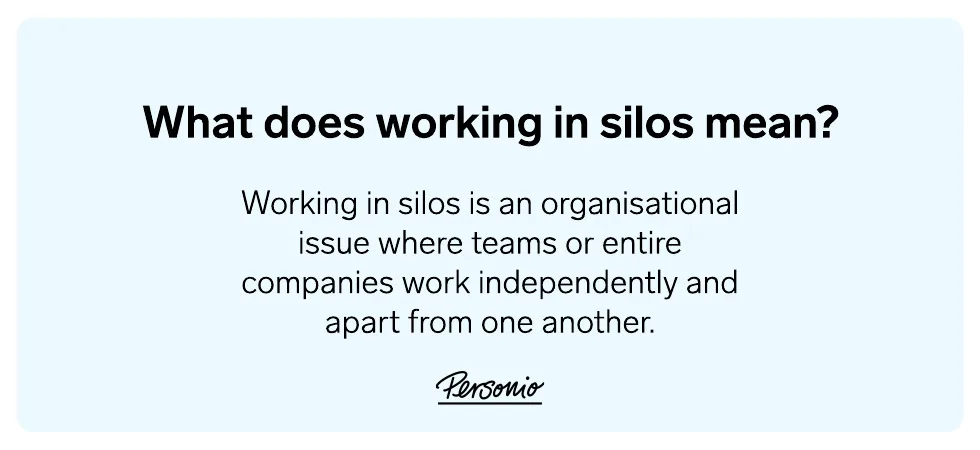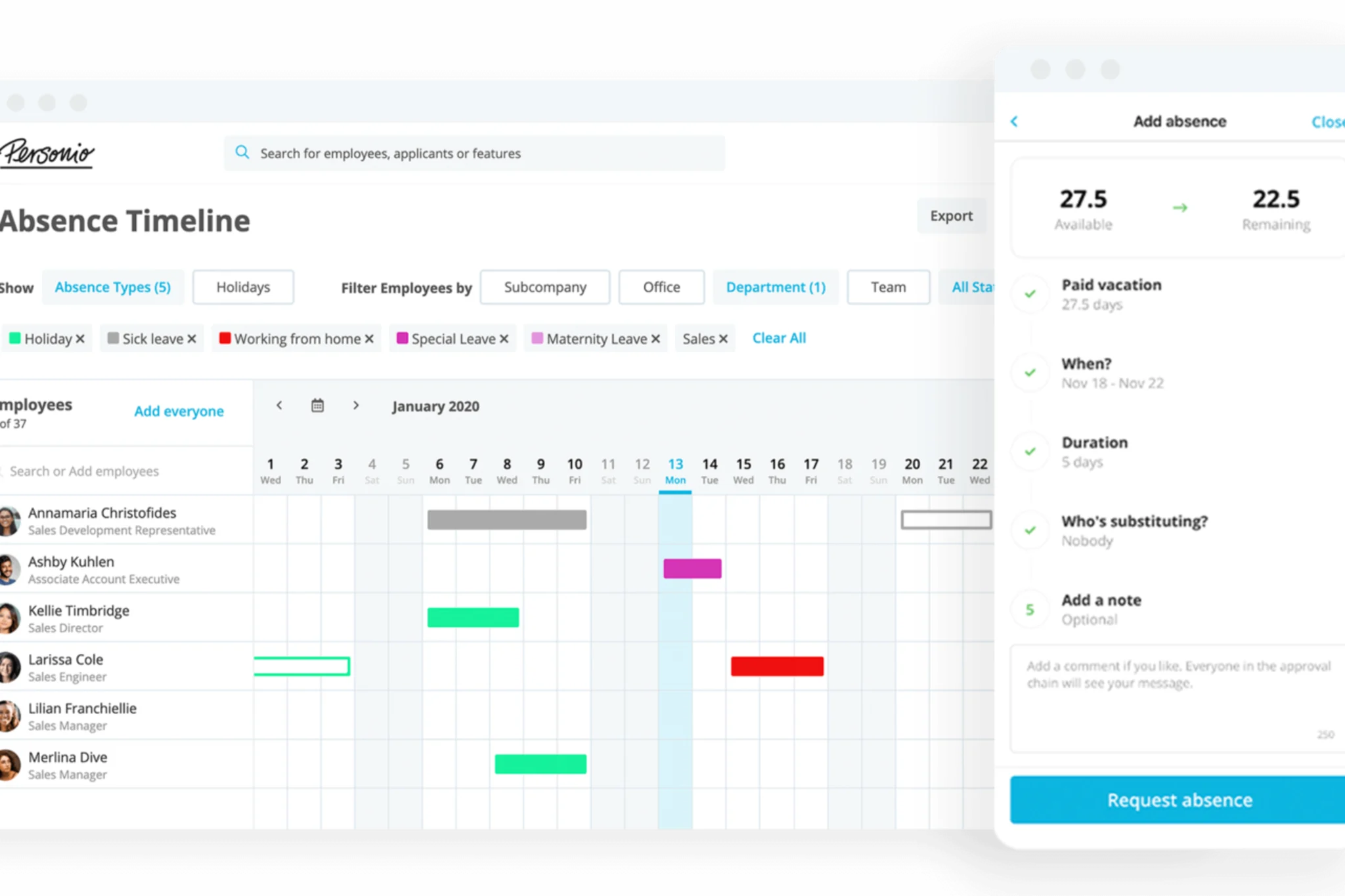How Can You Overcome Working In Silos?

Is your business at risk of working in silos? If you’ve found people shrugging their shoulders and saying, “that’s not my job”, felt like you’re working in opposition to others or blaming failures on other divisions or departments, then you have probably been suffering from the silo effect.
In this article, we describe what it means to be working in silos, the signs, the dangers and the alternatives. Then we share a few strategies you can use to avoid or overcome a silo mentality.
Make way for more progressive HR practices with Personio today.What Does Working in Silos Mean?
Working in silos is an organisational condition wherein a team (or group of teams) intentionally insulates itself from other teams or the entire organisation. The practise typically involves hiding information, not collaborating well or simply doing work misaligned with company goals.
This is enabled and encouraged by what is referred to as a ‘silo mentality’. This is when employees have a hard time seeing beyond their own ‘world of work’. Silo mentality is dangerous because it is the natural enemy of both collaboration and transparency at work.
First described by Phil Ensor in 1988 as ‘functional silo syndrome’, when you’re working in a silo, it means your team is working in isolation or a vacuum, not as part of a larger group.
The Top 13 Signs that You’re Working in Silos
How do you know if your organisation is working in silos? Here are some troubling signs:
Teams work in a vacuum from other individuals or departments.
There is little, no, or reluctant information sharing between groups.
There are unhealthy conflicts between departments, divisions or business units.
Leaders work in competition with each other, rather than collaborating.
A lot of time and energy is spent dealing with office politics.
People are not aligned, usually because there isn’t a clear vision that inspires or enables teams to work together
The hierarchy promotes separateness rather than cohesiveness.
Teams compete for resources, rather than focusing on what they could achieve together, efficiently.
Teams and team leaders frequently argue about responsibilities or ‘pass the buck’.
People focus on individual concerns or objectives, without thinking about how this might impact others or the business as a whole.
Relationships between teams (or even team members) are sour.
There is little trust in the company’s leadership.
Employees feel demotivated and unable to change the culture or work comfortably within it.
The Key Dangers of Working in Silos
Working in silos doesn’t just create stressful environments, it also reduces efficiency, creates pressure on resources and increases complexity. But there are other dangers, too:
Poor communication
Reduced trust
Lower morale
A lack of
Lower productivity
Wasted time
Duplicated effort
Less teamwork leading to fragmented business processes
Less innovation
A bad
Selfish or isolationist decision making
Misunderstanding the organisation’s purpose, mission and values.
Resources are wasted
It can cost more
Let’s consider an example of how working in silos creates wasted time and effort.
Say your business needs to check someone’s references before you hire them. Your HR team needs these references, as does the department hiring them and, in this example, your legal team.
If you are working in silos three different people might run the same reference checks. That isn’t just a waste of time and effort, the unnecessary cost of duplicating work means the organisation, as a whole, suffers.
Working in Silos vs. Collaboration
There is an alternative to working in silos: collaborating. There’s a massive difference in the attitude, feeling and stress level between an organisation where people work in silos and one where collaboration is the norm. When leaders and teams collaborate, the entire dynamic shifts from adversarial to cooperative, from disjointed to communal.
People’s attitudes change, too.
A collaborative organisation feels different. When collaboration trumps competition, people feel safer. This increased psychological safety means employees are less likely to feel their psychological contract is being violated.
The advantages of collaboration and breaking down silos can include reduced absenteeism, lower attrition, a smaller chance of burnout, greater employee engagement, a better employee experience, higher motivation and increased happiness at work.
Strategies to Avoid a Silo Mentality
Leaders who know that collaboration is better than working in silos do well to adopt an anti-silo mentality and consider taking any (or all) of these steps.
Model Collaborative Behaviour
If the silo mentality is coming from your leaders, then their leadership behaviour needs to change. As an article in Motivational Leadership explains, “leaders will need to role model what they expect from their team and create effective and long-term solutions to dispel silo mentality, both in their working style and that of their team members.”
Break Down Hierarchies
Your organisation may be structured with a lot of levels and significant separation between departments. Sometimes that’s necessary. But be careful to ensure that it doesn’t hinder open communication or collaboration.
Start by creating individual and team goals that align with broader business objectives. Sometimes you might need to encourage or, if necessary, force ‘warring’ teams to agree on objectives.
For example, if sales and marketing agree on the definition of a lead and when a lead is ready to be handed over from marketing to sales, friction can be reduced enormously.
Call Out Divisive Behaviour
While you might not be able to change another team member’s behaviour, it’s important to model ideal collaborative behaviour between yourself and your peers.
If a member of your team is being isolationist, not sharing information or deliberately avoiding working with others, call it out.
You can also call out successes – like if someone was going to take a siloed approach, but didn’t. It also helps to celebrate team success, rather than individual success and encourage individuals to thank and call out others who made their achievements possible.
Communicate Openly and Regularly
A TEDx presentation by Simone Vincenzi talks about how important collaboration is between groups in a talk entitled, “Sleeping with your clients”. While he literally shared office space with (and, occasionally, slept in the same venue as) his clients, you don’t need to go that far.
Just make sure that anyone who is working on a project knows what they need to do, when and why they need to play this role. Beware of inviting parties to too many meetings, though.
If in doubt, work with the RACI matrix – share relevant information to those Responsible, Accountable, Consulted or Informed.
Be Clear On the Bigger Picture
If your team struggles to work with others, help them understand why what they do is important in the broader context.
And, wherever possible, encourage your peers and leaders to do the same.
Make the Value of Collaboration Clear
Some of the best companies to work for include collaboration in their company’s core values. If your workplace promotes a divisive culture, it might be hard work to help people recognise that the obvious but trite acronym, TEAM, stands for Together Everyone Achieves More.
It’s true, though. When individuals realise that someone’s got their back, they give more and receive more in exchange. It helps to welcome and encourage new ideas and to nurture and support employees. In exchange, this promotes more ideas and greater collaboration.
Encourage Team Collaboration Through Fun
Teambuilding exercises can be tricky to do in remote or hybrid environments, but it is possible to create opportunities for team members to talk with those they would normally bump into at the water cooler or in the kitchen, even if they work remotely.
Some companies have seen success by setting up ‘get to know someone’ meetings. People from different teams or even divisions are matched up together to chat for 15 minutes a week. Even if this doesn’t work for you, ask your team members for original or interesting ways to bring teams together and remove divisions. But make sure managers do it, too!
Use Technology To Enable Collaboration
Better collaboration means less duplication. The less repeated effort involved in running a business, the better. That’s why it’s wise to streamline tasks, especially those that overlap, to centralise them and make it super easy for people to find, input and manage information.
Those are some of the principles on which we built our all-in-one HR solution because we want to encourage HR leaders – and everyone they interact with at work – to spend less time on processes and more time on people.
We’d love to share how Personio can help with everything from recruitment to HR management, preliminary payroll, performance and more. Take a look at all the HR processes we help automate, in one tool or start a free trial.
The Solution to Working In Silos
Ultimately, working in silos is bad for our mental health, workplace harmony and the bottom line.
You can spot signs that your company might be working in silos if there’s a lot of competition for resources, a lack of information sharing, unhealthy politics, a lack of trust and generally bad relationships between teams. But a siloed organisation can be turned around, with effort.
When that happens, employees get happier, the chances of them leaving reduces, their motivation goes up and so does productivity.
So, if you want to root out organisational silos, start with your leadership. Then get the tools you need to help improve collaboration and use them.


